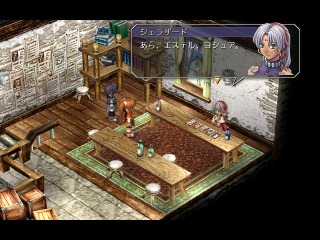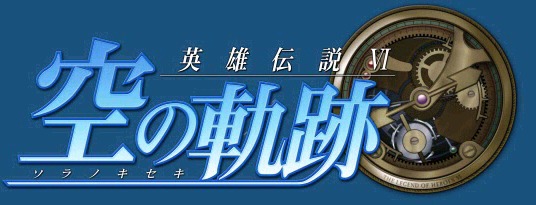

By Kimimi w/ edits by SpaceDrake - last updated 4/8/2011
Characters
Legends of Heroes: Trails in the Sky / Eiyuu Densetsu VI: Sora no Kiseki - PC Windows / PSP (2004/2006)
Cover Artwork
Sora no Kiseki FC
Sora no Kiseki FC
MP3s Download here
Sora no Kiseki
Sora no Kiseki FC
Eiyuu Densetsu VI: Sora no Kiseki SC - PC Windows / PSP (2006/2007)
Soundtrack Artwork
Sora no Kiseki SC
Sora no Kiseki SC
MP3s Download here
Fateful Confrontation
Sora no Kiseki SC
Eiyuu Densetsu VI: Sora no Kiseki The 3rd - PC Windows / PSP (2007)
Cover Artwork
Sora no Kiseki The 3rd
Sora no Kiseki The 3rd
This game takes a big departure in its storytelling style both from the previous chapters and other RPGS - the game's focus is on the cast to the exclusion of almost everything else, by creating a plot that forces them into an illusory world with almost no one else to interact with. It sounds rather limiting, but it works quite well as they encounter fragmented parts of familiar places and people within them. The darker tone and this new style does feel a bit strange after the first two but as you go through it all clicks into place and serves as a fitting end to the trilogy. And, of course, it ends up serving as a perfect excuse for the most psychedelic visuals in the entire series.
MP3s Download here
Cry for Me, Cry for You
Sora no Kiseki The 3rd
Sora no Kiseki The 3rd
The plot is further expanded by taking on voluntary quests from the various Bracers Guild HQs dotted around Liberl. The extra money and items are certainly welcome, but it's the little tidbits you get from the characters that make them really worthwhile. They aren't necessary by any means, but failure to rise up through the ranks will result in some characters berating your lack of effort or offer up humiliating put downs when you boast of your unimpressive position within the guild. The game features an excellent quest journal for your Bracer jobs - notes are jotted down in it as you gather information on quests and it also contains a thorough guide on the Orbment system as well as logs of enemies defeated and similar data.
In addition to the excellent job they did creating the characters Falcom went a step further and made sure the world they inhabited was a place and not merely a collection of areas arranged for the sake of convenience. Take Rolent for example; this town is the first one you encounter and close to the home of the main cast members. You can learn if you wish that Rolent has two main industries - agriculture and septium mineral mining. Does that make any difference to the gameplay? No, none at all. What it does do is show the level of care and detail that went into creating the world as a whole, instead of creating a plot and fashioning bits and pieces around it. The Third is pretty much based around the concept of exposing you to fragmented little pieces of background info, as the game is filled with doors that lead to special character-specific events.
In terms of scale, the game world is "Suikoden sized" - the series is set entirely within the Liberl kingdom, although you are made aware of the surrounding areas and fed some small details about them. The next game in the series, "Zero no Kiseki, is set in the not-too-distant State of Crossbell, and yet another game is coming with that cast, so Falcom is hardly done with this nascent franchise yet. It does not, however, tie directly into the Gagharv Trilogy. It technically does not take place in the some world, although some have speculated it's simply on a different continent altogether.
Of course, the crux of any RPG is the battle system. There are no random battles, and all enemies are visible on the map. At heart, it's a turn based one, with turn order displayed at all times in a manner similar to Evolution/Final Fantasy X/Xenosaga. It's important to learn how to manipulate turn order through haste spells, stunning the enemy, and support items, because the enemy will try to use this system against you as well. The time spells take to cast must be taken into consideration too - it's possible for enemies to simply move out of the way of offensive spells if they have the time, and if you're trying to cast a group healing spell you have to make sure everyone stays within the area of effect. Battles play out on a grid system, with physical attacks having varying ranges and effects - certain skills can knock you back, cancel spellcasting or change your characters position on the field. In many ways, it's a bit like Lunar or the PSP remakes of the Gagharv Trilogy, with each character limited in how far they can move in a given turn. There are also flash special attacks executed once you've bulit up enough power. SC introduces "chain crafts" into the mix - a skill where multiple characters attack simultaneously, and The Third adds a support character option - rather than sitting idle, the player can choose a spare party member not participating in battle to offer set stat boosts to the others.
Magic is handled through a materia-like system. Falcom expanded upon it in several ways however - "quartz" (materia, for descriptive shorthands sake) isn't placed into equipment, but onto an item called an Orbment. This has a fixed number of slots and each character has a unique layout that cannot be altered; in addition to this some slots can only contain certain kinds of quartz forcing you to play to each characters natural strength and preventing any kind of perfect setup. The order you place them in also effects the spells you gain from them too - it's possible to equip the same character with the same quartz, but result in a different spell set at the end of it. Messing around with this Orbal system is very easy and you see the results instantly, so experimentation is straightforward enough.
As mentioned at the beginning, the Legend of Heroes series is known for being story heavy and Sora no Kiseki certainly doesn't disappoint. The main cast are a varied bunch, backed up by a strong group of supporting characters and adversaries. The writing doesn't allow the characters to sit within a lazy stereotype - there comes a time where your party are trapped within their own individual perfect dream worlds (you only ever get to see this from Estelle's point of view) and when asked what he dreamt of Olivier, the joker of the group with an eye for the ladies, simply says he dreamed he was with his elder brother when they were younger, and he never speaks of it again.
There's still plenty of time for the big events too - ancient secrets are discovered, a dragon lands in the middle of a shopping district and an invasion is narrowly avoided, but the plot never loses sight of the people that are forced to live through these decisions and never takes the easy road of painting the opposition as pantomime-level evil.
Even the soundtrack is a departure from the fast paced guitar-laden tracks of Ys - it's more melodic and instrumental, with several tracks such as "Silver Will, Golden Wings", "Whereabouts of the Stars", and title track "Sora no Kiseki" often remixed as everything from a heart-pumping boss fights to slower, more thoughtful tunes.
Although the first game was released in 2004, it wasn't until 2010 that a publisher was finally willing to commit to localizing the truly epic amount of text in each game, and take the risk required to bring the games to Western markets. XSEED released FC on March 29, 2011 for the PSP (with statements indicating that they'd like to put the PC version on popular digital distribution networks like Steam, as well), with SC's release dependent on the success of FC, and coming in 2012 at the earliest. Happily, however, they are committed to bringing the entire franchise over, so long as it is even marginally successful. Meanwhile, as noted, Falcom is up to the fifth "Kiseki" game, with indications that they may still continue the franchise further, since the first three games together have sold well over a million copies just in Japan at this point.
This game-cum-series-cum-franchise has been one of Japan's best kept secrets for years. It brought Falcom back to fore-front prominence in Japan, and inspired a wave of independent PC RPGs, many of which still have not left that country. It's been a long road, but the West can finally see what all the fuss is about.
Links
XSEED's Trails in the Sky Page - With more information, and links on where to buy FC. This is the place to watch for announcements about any future game localizations!
Endless History - A fansite devoted to Falcom's releases, particularly the Trails series. An excellent source of news and updates.
Sora no Kiseki FC
Sora no Kiseki FC
Sora no Kiseki SC
Sora no Kiseki SC
Sora no Kiseki SC
Sora no Kiseki The 3rd
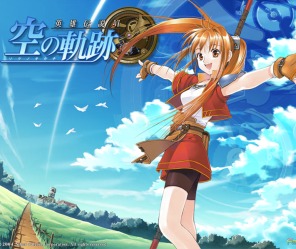


Known as "First Chapter" or simply "FC", this game begins when Estelle and Joshua embark on life as Bracers, travelling around Liberl together and carrying out quests provided by the local guilds. Over the course of the game, they uncover a plot that could threaten the entire nation and resolve to stop it... only to have the situation explode in their faces in a way that no one saw coming. The very end contains particularly painful revelations for Joshua, who leaves the group - and the Brights, including the name - behind in order to settle old scores.
Whereabouts of the Stars - Full Version
Whereabouts of the Stars - Harmonica Long Version
Path of a New Journey
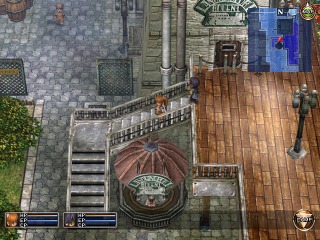
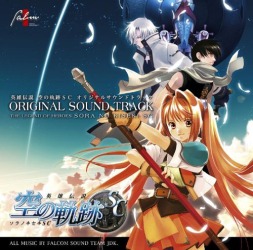
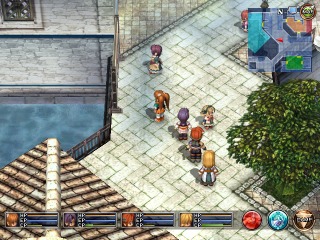
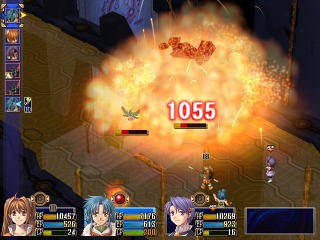
The Second Chapter begins the very next morning after the previous adventure. Estelle realizes that Joshua is likely running straight into a trap, or at least a situation he cannot possibly handle by himself; however, her attempts to find him end in failure, and she resolves, with the aid of her companions, to train herself to the point where she can put an end to the plot revealed at the end of FC and ensure that Joshua does not get himself killed. Meanwhile, the conspirators behind the events of both chapters advance their plans... and they and Estelle's group finally collide in a climatic showdown among the trails in the sky of Liberl.
Feeling like Dancing with Air
Silver Will Golden Wings
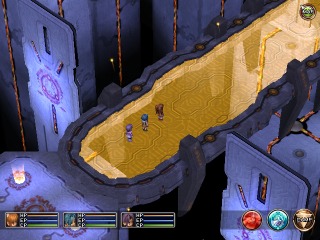
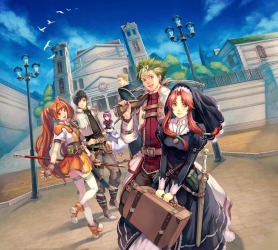


The final game focuses on Kevin and his troubled past. He and Ries become trapped in an illusory world created by a being calling itself the Lord of Phantasma. They find their friends are also drawn to this place, and after many skeletons are pulled out of Kevin's closet they confront the Lord of Phantasma and discover the Lord's proper identity. Once they have put the Lord to rest, everyone escapes that strange land, going their separate ways.
Fighting Right On
Masquerage of Lies
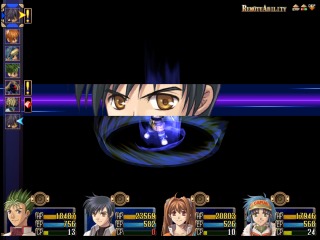
This trilogy has a somewhat unique and demanding expectation of its players - the story expects players to play them all in order, and it makes no concessions for anyone trying to dive into them any other way, as there's no Xenosaga-style database to use for reference. There's barely a break in the plot - the second game begins the morning after the night FC ended; same place, same characters, carrying on like before. This does have its benefits - your save data can naturally be carried over, and any NPCs you were helpful to in the past game will comment on your actions which is a nice touch. From a plot point of view it forces them to deal with that recurring plot puzzle - what happens to the characters after the credits roll. Far more than just "Hey gang, let's have more adventures!" they take the bull by the horns and show how these people have been shaped by their experiences and how they have moved on.
